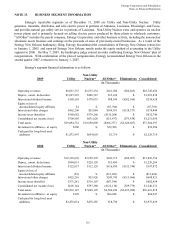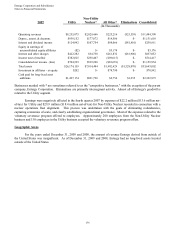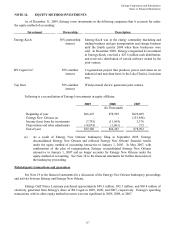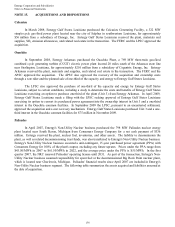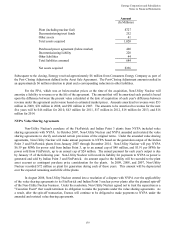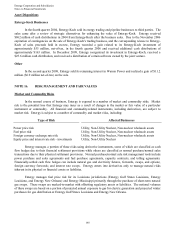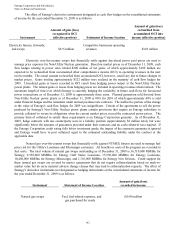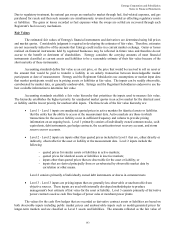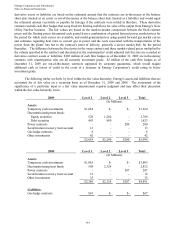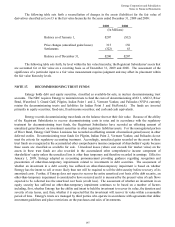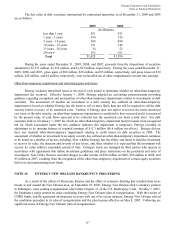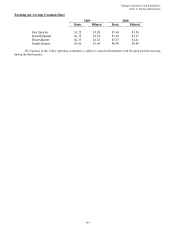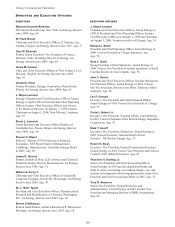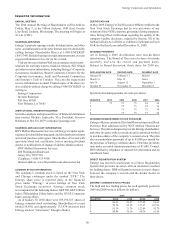Entergy 2009 Annual Report Download - page 147
Download and view the complete annual report
Please find page 147 of the 2009 Entergy annual report below. You can navigate through the pages in the report by either clicking on the pages listed below, or by using the keyword search tool below to find specific information within the annual report.
Entergy Corporation and Subsidiaries
Notes to Financial Statements
143
The following table sets forth a reconciliation of changes in the assets (liabilities) for the fair value of
derivatives classified as Level 3 in the fair value hierarchy for the years ended December 31, 2009 and 2008:
2009 2008
(In Millions)
Balance as of January 1, $207 ($12)
Price changes (unrealized gains/losses) 315 156
Settlements (322) 63
Balance as of December 31, $200 $207
The following table sets forth, by level within the fair value hierarchy, the Registrant Subsidiaries' assets that
are accounted for at fair value on a recurring basis as of December 31, 2009 and 2008. The assessment of the
significance of a particular input to a fair value measurement requires judgment and may affect its placement within
the fair value hierarchy levels.
NOTE 17. DECOMMISSIONING TRUST FUNDS
Entergy holds debt and equity securities, classified as available-for-sale, in nuclear decommissioning trust
accounts. The NRC requires Entergy to maintain trusts to fund the costs of decommissioning ANO 1, ANO 2, River
Bend, Waterford 3, Grand Gulf, Pilgrim, Indian Point 1 and 2, Vermont Yankee, and Palisades (NYPA currently
retains the decommissioning trusts and liabilities for Indian Point 3 and FitzPatrick). The funds are invested
primarily in equity securities; fixed-rate, fixed-income securities; and cash and cash equivalents.
Entergy records decommissioning trust funds on the balance sheet at their fair value. Because of the ability
of the Registrant Subsidiaries to recover decommissioning costs in rates and in accordance with the regulatory
treatment for decommissioning trust funds, the Registrant Subsidiaries have recorded an offsetting amount of
unrealized gains/(losses) on investment securities in other regulatory liabilities/assets. For the nonregulated portion
of River Bend, Entergy Gulf States Louisiana has recorded an offsetting amount of unrealized gains/(losses) in other
deferred credits. Decommissioning trust funds for Pilgrim, Indian Point 2, Vermont Yankee, and Palisades do not
meet the criteria for regulatory accounting treatment. Accordingly, unrealized gains recorded on the assets in these
trust funds are recognized in the accumulated other comprehensive income component of shareholders' equity because
these assets are classified as available for sale. Unrealized losses (where cost exceeds fair market value) on the
assets in these trust funds are also recorded in the accumulated other comprehensive income component of
shareholders' equity unless the unrealized loss is other than temporary and therefore recorded in earnings. Effective
January 1, 2009, Entergy adopted an accounting pronouncement providing guidance regarding recognition and
presentation of other-than-temporary impairments related to investments in debt securities. The assessment of
whether an investment in a debt security has suffered an other-than-temporary impairment is based on whether
Entergy has the intent to sell or more likely than not will be required to sell the debt security before recovery of its
amortized costs. Further, if Entergy does not expect to recover the entire amortized cost basis of the debt security, an
other-than-temporary impairment is considered to have occurred and it is measured by the present value of cash flows
expected to be collected less the amortized cost basis (credit loss). The assessment of whether an investment in an
equity security has suffered an other-than-temporary impairment continues to be based on a number of factors
including, first, whether Entergy has the ability and intent to hold the investment to recover its value, the duration and
severity of any losses, and, then, whether it is expected that the investment will recover its value within a reasonable
period of time. Entergy's trusts are managed by third parties who operate in accordance with agreements that define
investment guidelines and place restrictions on the purchases and sales of investments.
145


